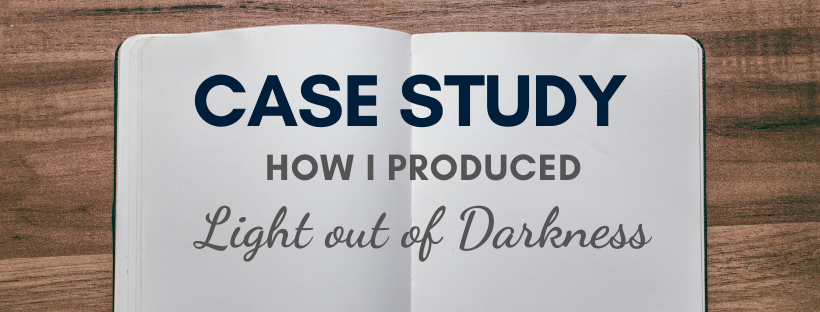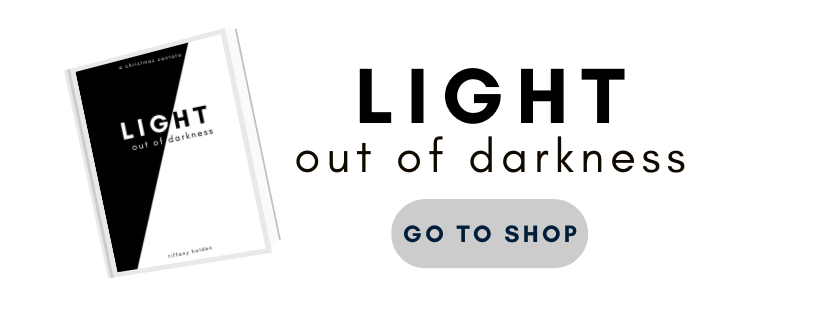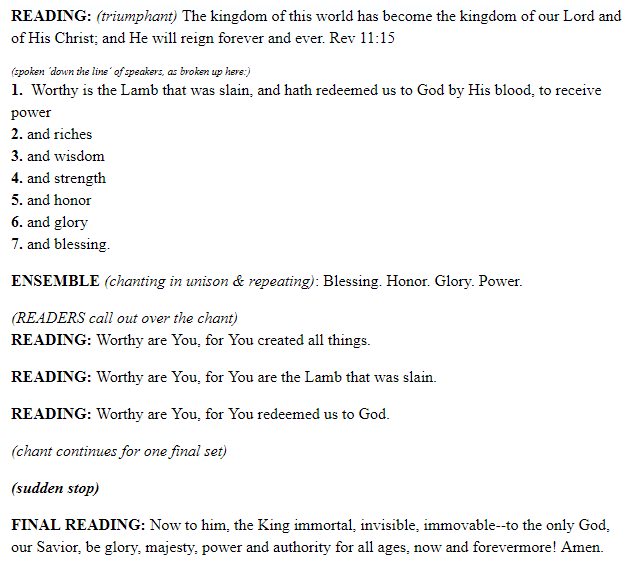Until one day, Man and Woman chose their own will over the will of God. And darkness covered over the land. A Darkness of separation, of lost communion, of disgrace, of sin. Thorns and thistles infested the earth. Man toiled by the sweat of his brow to produce food. Woman gave birth to children in agony. Mankind fought with one another, murdered one another, and in the end died themselves.
So hopefully by now you’ve been to Brainstorm Central: 15 Concepts and 50 Components for the effects and tactics you can use to tell your story most effectively.
Now let’s see how it can actually work, in a real Christmas production I put together in 2017, called Light out of Darkness. I put the bulk of the program together in the spring, then started production in earnest in late August.
Here’s how the script came together:

Quick Summary
I broke down Light Out of Darkness into the following sections:
1. Paradise Lost (“Let there be light”; God’s creation and Man’s sin that cast the world into darkness. A summary of the Old Testament, leading up to the events of Christmas)
2. The Dawn is Come (Mary’s fears, faith & her response to the angel’s announcement)
3. Led by the Light (the birth of Jesus, and Joseph’s fears and his response of faith)
4. Light of the World (the crucifixion and resurrection of Jesus, and our response of faith)
5. The Kingdom of Our Lord (triumphant praise to the King who conquered darkness forever)

Repeated components
I believe in purposeful repetition-with-variety. Repetition helps you organize the structure of the production, and creates auditory tags that your audience will recognize. As we become an increasingly visual society, it’s important to use a strong structure in this type of auditory-based production, to avoid losing the audience.
How I did it:
I opened each of the three middle sections (Mary, Joseph & the Cross) with one of the three stanzas of “O Holy Night”, sung by a male quartet with a piano backdrop.
There were four special numbers, one for each major section (the last section was a two-minute closing epilogue). The first and last were group special music, to emphasize the community of creation at the beginning, and our united response of praise to our Savior at the end. The two others were solos, and sung from the perspective of Mary and Joseph.
- Section 1 (Creation/Paradise Lost): “Creation Song” by Fernando Ortega
- Section 2 (Mary/The Dawn is Come): “Magnificat” by Keith & Kristin Getty
- Section 3 (Joseph/Led by the Light): “I Heard the Bells on Christmas Day” by Casting Crowns
- Section 4 (Cross/Light of the World): “Let There Be Light” by Point of Grace
- Section 5 (Triumph/The Kingdom of Our Lord): no special music
Two actors read Mary and Joseph’s monologues from our sound booth in the back (this gave the effect of the audience listening to their inmost thoughts). We left the stage empty and dimmed the lights, and projected the words MARY and JOSEPH on the screened, in scratched white block letters on a dark background.
I used layered speaking to communicate the six days of Creation at the beginning, and again at the end to create a “cacophony of praise”, inspired by the scene in Revelation 4:

We avoided chaos by carefully timing it and coordinating the volumes of the participants’ voices, so the effect was of power under control.
Power Clusters
In any production, there should be a few moments that you do your best to create magic. I call these Power Clusters– a blend of multiple visual and auditory components in quick succession. With the crew size I had (and with the desire to make this a ‘minimalist’ production) it would have been far too difficult to carry this complexity throughout an entire production. So I choreographed just a few moments as special effects at key points.
For example, at the end of our prologue, we’ve hinted at the prophecies of a Deliverer, but are creating a sense of despair at Israel’s repeated rebellion, before transitioning to an upswing of hope:

Okay, let’s break this down. I’m creating a sense of despair, sadness, and suspense, and end with hope. And this section takes only about a minute out of the whole 45-minute production!
Visual: we’re dimming the lights (to complete darkness). The participants (six to eight people) leave their posts in the lineup of mics and drift back to their seats further back on the platform. The screens show a succession of phrases from Psalm 2, and I even mixed up the fonts and timing a bit so that “…against the Lord” is subtly emphasized. The lights then come up to bright again, once the last line is spoken.
Auditory: I found an online clip of someone singing a Psalm of Lament in Hebrew. It had just the sound to match the tone of the moment, and the actual words they are singing are from another, relevant Psalm (so there’s internal integrity; it’s not just some random thing I’m using because it “sounds cool”). The last line is spoken from the back, giving it a narrator/voice-from-above effect.
Surprises
I see surprises as dashes of spice in a production – they’re unexpected, memorable, and when used correctly, enhance the overall flavor of the production. Use them sparingly – you don’t want your production to seem gimmicky!
How I did this: At one point, an actor interrupted the narrative by hollering from the back of the room, jerking the audience out of the complacency of narrative, into a here-and-now action:

Or at another part – Joseph is waiting outside the stable as Mary is in labor. Towards the end of his monologue, he slowly begins to realize the weight of Messiah’s mission:

Playing a clip of a baby crying again took this moment and made it a semi-reality for the people in attendance.
The script took weeks to put together, made up of a lot of writing sessions in a local coffee shop (just like right now, actually!) And let me tell you, all the hours of wrestling with the words and typing out Scripture and listening to hours of music in search of just the right songs was 100% worth it. I’ll never forget the feeling of standing (too antsy to sit) in the back of a darkened sanctuary while eternal words of truth that I had spent months packaging were presented to a captivated audience.
I think when we are creative in our giftings – whether it’s writing, or singing, or painting, or coordinating, or whatever it might be – that we are acting in the image of God, an image that He has imprinted on us. Is it any wonder it is so fulfilling?
Where to go next:


